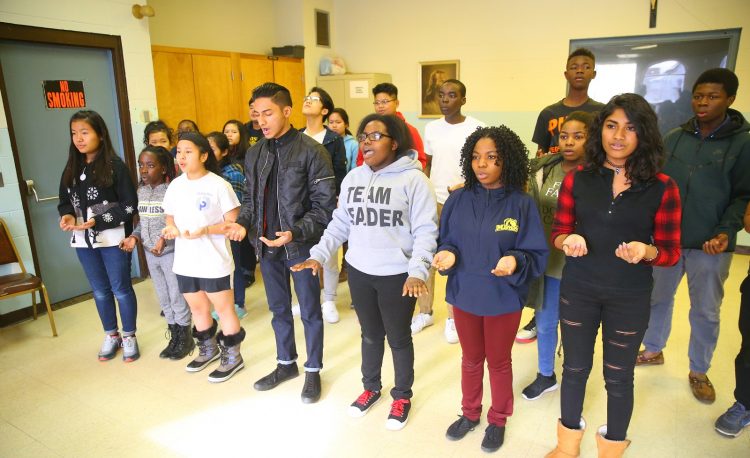A choir of young refugees takes on ‘Fiddler on the Roof’
On the first Saturday of the New Year, a chorus of young voices floated down from a secondfloor classroom next to Our Lady of Hope Catholic Church on Lafayette Avenue.
Jan 29, 2017

VIRGINIA: On the first Saturday of the New Year, a chorus of young voices floated down from a secondfloor classroom next to Our Lady of Hope Catholic Church on Lafayette Avenue.
If you pressed your ear to the door, you could just make out the plaintive lyrics of a song about a fictional village in western Russia:
“A-na-tev-ka, A-na-tev-ka. Intimate, obstinate Anatevka, where I know everyone I meet,” they sang. “Soon I’ll be a stranger in a strange new place, searching for an old familiar face.”
The members of Our Lady of Hope’s youth choir, who escaped as children from villages or refugee camps in Africa and Asia, were once strangers in a strange new place called Buffalo.
But after years together as members of one of the city’s most diverse congregations, they’re now close friends. And they have staked their claim on this multicultural corner of Buffalo.
Under director Jennifer Serniuk, choir members have spent months rehearsing for a production of the classic refugee musical Fiddler on the Roof. They performed the show on Jan 18 in the Maxine and Robert Seller Theatre in Amherst.
As Buffalo works to burnish its reputation as a welcoming home for international refugees, this act of cross-cultural fusion is a symbol of the city’s refugee-driven renaissance. Each voice in the choir represents a different refugee story.
One belongs to Florence Ndayishimiye, a freshman at Erie Community College who came to America with her family from a camp in Tanzania when she was 9. Another belongs to Lay Lay Too, 13, whose family fled Burma for a camp in Thailand and came to Buffalo when he was 3 years old.
Still another, the baritone of the show’s lead character Tevye, belongs to high school sophomore Richard Manuel. The 16-year-old came to Buffalo with his family in 2013 after fleeing Burma for a temporary home in Malaysia and finally a new life in the multi-ethnic bastion of Buffalo’s West Side.
Together, those voices have merged to put a unique stamp on one of the most popular American musicals in the canon. More than that, they have demonstrated the speed with which young people from diverse backgrounds can integrate into the life and culture of a new city.
“They have dealt with some hardships in their life and they didn’t grow up in the nicest of circumstances but they’ve really blossomed here,” said Serniuk, a longtime parish member and doctoral student in the University at Buffalo’s education programme. “And they’ve embraced show tunes. What more can I ask for?”
The villages many of the choir members hail from in Asia and Africa, such as Anatevka, are often small, tight-knit communities subject to frequent and unpredictable violence.
But most of the choir members came to the United States when they were too young to remember the trauma of their journey. They are fluent English speakers, most with little trace of an accent.
“I actually felt a lot at home in Buffalo, and in America,” Manuel said when asked if he felt the same sense of dislocation as the characters in Fiddler who were driven out of their village.
But there were other parts of the show that reminded him of his own life, especially Rich Man, in which Tevye muses about how his life would be different if he had money.
“It relates to my father a lot,” he said. “At home, he’s always talking about how he’s going to start his own business one day, just sitting there on the couch and telling me all these stories about Burma and his father. It reminded me of Rich Man, because one day, we’ll be rich. We’ll build up a home again.”
Asked if he was surprised about the similarities between his culture and that of the Russian Jews depicted in Fiddler on the Roof, Manuel nodded. “We all face the same problems,” he said.
“We all face the same joys.”
With the help of Serniuk and others in the church, they have helped to turn their parish and their community into a comfortable enclave — a new village filled with familiar faces.
“When we started, all the Karen kids would sit together and all the African kids would sit together, but now they’re all friends and they hang out with each other outside the church,” she said.
Serniuk said the task of honouring Jewish culture and history with this production was very much on her mind, as she explained in a conversation with one of her Jewish instructors at UB.
“She said that Fiddler on the Roof is very near and dear to our hearts because it’s a musical about our culture and our traditions. And I said, ‘I’m sure you’ve never seen it like this before.’ ” -- Buffalo News







Total Comments:0